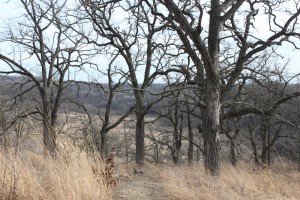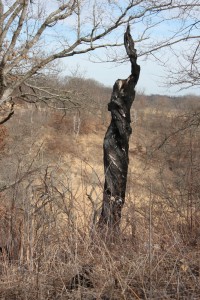We humans long outlive most of the species we interact with. Our cats and dogs accompany us for about fifteen years at most; livestock rarely make it more then a few; our garden annuals live, by definition, only one season. Many of the insects that bug us in summer will be gone within weeks, having done their evolutionary duty and spawned the next generation. Our environment is a bustling funeral parlor, and we the unknowing bystanders to a hectic daily schedule of corpse deliveries, wakes, burials, and rebirths.

Bur oaks in the Pleasant Valley Conservancy, one of the few remaining patches of oak savanna in southeastern Wisconsin. Photo by Beate Popkin
But then there are the trees. Trees have figured out the longevity game. The longest-lived individuals on earth are trees over four thousand years old; if you count clonal tree colonies like aspens, you can go back at least 80,000 years. Even our familiar oaks can easily outlive us by a factor of five or more, under good conditions. Trees have achieved this Methuselan longevity by trading mobility for rootedness, making the implicit (and until humans came around, mostly reasonable) assumption that conditions aren’t likely to change drastically within a lifetime. By staying in one place, trees can grow roots that extend far below ground, allowing them access to deep stores of water and nutrients that nurture them through centuries of floods, droughts, and whatever else nature throws at them.
Unfortunately, conditions are changing, and fast. Scientists predict that the carbon dioxide and other greenhouse gases we are putting in the atmosphere will lead to an increase in average annual temperature in Wisconsin of around 6.5 degrees Fahrenheit by 2055, relative to 1980. Depending on how voracious our appetite for fossil fuels continues to be, and whether global warming triggers various positive feedbacks leading to more greenhouse gas emissions, we could see future warming on the same scale. Plants that have been used to relatively stable conditions for millennia will suddenly need to “move” north, not by packing up and walking, but by throwing their seeds as far as they can and hoping they produce offspring. The scientific term for this is dispersal, and for trees it is typically limited to a few miles, or less.
Ecologists talk about “climate envelopes” in which different species can live. For trees, these can be vast areas, or relatively limited niches. As the planet warms, tree climate envelopes in the Northern hemisphere will shrink and shift north, in many cases by hundreds of miles, according to a 2007 paper in the journal Bioscience. Tree seed dispersal, on the other hand, seems to be limited to around 30 miles per century–not likely to be a winning pace in the race against warming.
The good news is that climate change alone will not doom most (or perhaps any) of Wisconsin’s trees to total extinction. However, species like black spruce, balsam fir, and paper birch may be packing up and leaving the state for good in the near future, according to the Wisconsin Initiative on Climate Change Impact’s 2011 report. The northern forests of Wisconsin are already at the southern edge of these trees’ ranges, and sometime later this century they will no longer find this state a hospitable home. In southern Wisconsin, tamarack swamps–an ecosystem already beset by multiple plights–may fall victim to warming as well. Other species will be more than happy to take the places of the departed, but the biodiversity represented by native ecosystems will never be replaced.
The aforementioned oaks are having problems of their own. Southern Wisconsin, especially around Madison, used to be a mix of prairie and oak savanna. Prairies need periodic fires to suppress tree growth; otherwise they soon become forests. But bur oaks, with their “thick crust of corky bark” (in Aldo Leopold’s words), are one of the few trees that can withstand these fires. Fire and oak together created a unique ecosystem that is now one of the most endangered in the United States, according to The Vanishing Present, a book co-edited by University of Wisconsin botanist Don Waller.
The European settlers who arrived in the middle of the 1800s, naturally not wanting their crops to burn down, suppressed the fires that had kept the prairie open for ages. And suddenly successional, fire-intolerant species started growing in places where they never could have gained a foothold before. But things change slowly in the world of trees, and it takes a trained eye to notice. We still have oak forests, but they are old now–oak seedlings are few, and grow mainly on poor soil. Good historical data can also help those with trained eyes describe the world around us today. Waller and co-authors described in a 2008 article in the journal Ecology a survey they conducted of sites that had also been surveyed in 1950. The scientists found that oaks have declined across Wisconsin, while maples, elms, basswoods, and others have increased. More significantly, perhaps, they measured a loss of biodiversity across all their sites–a harbinger, it seems, of things to come.
In the end, we will pass on from this life, and trees of some kind will bear witness. But what kind of trees they are matters. Trees have been the anchors of ecosystems since ancient times, and when they are gone, the lichens, understory plants, insects, and other animals they sheltered will not just be able to make their home in whatever kind of forest comes next. Many of them will have to move elsewhere, or perish. It seems we are looking at a simplified biological future with a relatively small number of winners, and a lot of losers.

Hi Gabe, I like your site and writing!